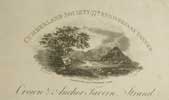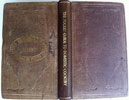The True Way
OF Preserving and Candying, AND Making Several Sorts OF Sweet-Meats, According to the Best and Truest Manner, Made Publick for the Benifit of all English Ladies and Gentlewoman; especially for my Scholars. LONDON, Printed for the Author, in the Year, MDCXCV.
The second edition 1695. 12vo. 1fep. Title page. 4p The Epistle Directory. 7-154. 6p The Contents. 1fep. Full contemporary dark brown calf with gilt lines and fillets on the boards. Spine with raised bands, gilt lines with a red label and gilt lettering. Text block uniformly but lightly age browned though-out. The last page has three light brown strips from previous old sellotape. Text not affected.
- There is a surprising similarity between this anonymous work, 'The True Way' and the two books bound in one volume, “Young Cooks Monitor of 1705 and Mary Tillinghast’s “Rare and Excellent Receipts” 1678. (see item # 10960 on this site under 'Tillinghast') The three books and receipts are remarkably similar with the three Title pages all proclaiming they are; "Made Publick for the Use and Benefit of my Scholars". The Epistle Directories of both books have the same similar statement addressed to her Scholars. (There is no Epistle Directory in Tillinghast's book). The 'True Way' does not have any indication of authorship, while the 'Cook's Monitor' has M.H. after the preface. This compiler suggests that Mary Tillinghast is the maiden name of the M.H. of the 'Young Cooks Monitor', and that sometime after writing/publishing her 'Excellent Receipts' in 1678, Tillinghast married and assumed her married initials of M.H. while keeping the authorship of 'The True Way' anonymous. At this point in time there is probably no way to prove this theory, but the startling similarities between the three works (bound in two volumes) are too evident to ignore. The BL holds two copies of 'The True Way', a first of 1681 and one copy of the 1695. A first edition of 1681, was sold from the John Lyle Collection at Bloomsbury Auctions, on June 2003. Lyle describes the 1st edition as 'extremely rare'. This edition not found in Vicaire, Oxford or Bitting. Wing locates copies in Leeds Brotherton, Clark Lib.in LA and NY Pub. Lib. One complete copy sold at Sotheby's in the Crahan collection at NY on Nov.18th 1986, but none recorded at auction in any other major collection. This one must also be considered rare.




click on image to enlarge

Antiquarian category
ref number:
10962 











































